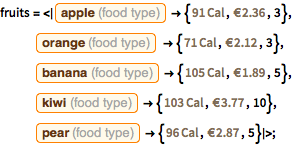Solve the Knapsack Problem
The new function KnapsackSolve provides an easy and user-friendly way for solving combinatorial optimization problems such as the knapsack problem. Knapsack problems appear in a large variety of fields, such as two-dimensional cutting problems and capital budgeting, and can be used to build cryptosystems.
This is a grocery list in which each fruit is specified together with its calorie content, average price, and maximum count.
In[1]:=

fruits = <|
Entity["FoodType", "Apple"] -> {Quantity[91, "LargeCalories"],
Quantity[2.36, "Euros"], 3},
Entity["FoodType", "Orange"] -> {Quantity[71, "LargeCalories"],
Quantity[2.12, "Euros"], 3},
Entity["FoodType", "Banana"] -> {Quantity[105, "LargeCalories"],
Quantity[1.89, "Euros"], 5},
Entity["FoodType", "Kiwi"] -> {Quantity[103, "LargeCalories"],
Quantity[3.77, "Euros"], 10},
Entity["FoodType", "Pear"] -> {Quantity[96, "LargeCalories"],
Quantity[2.87, "Euros"], 5}|>;Determine the number of fruits of each type that maximizes the calorie content for a given amount of money.
In[2]:=
counts = KnapsackSolve[fruits, Quantity[25, "Euros"]]Out[2]=
This is the calorie contribution from each of the fruit types and the total.
In[3]:=
fruits[[All, 1]] countsOut[3]=
In[4]:=
fruits[[All, 1]] counts;
Total[%]Out[4]=
This is the cost for each fruit type and the total cost.
In[5]:=
fruits[[All, 2]] countsOut[5]=
In[6]:=
fruits[[All, 2]] counts;
Total[%]Out[6]=























